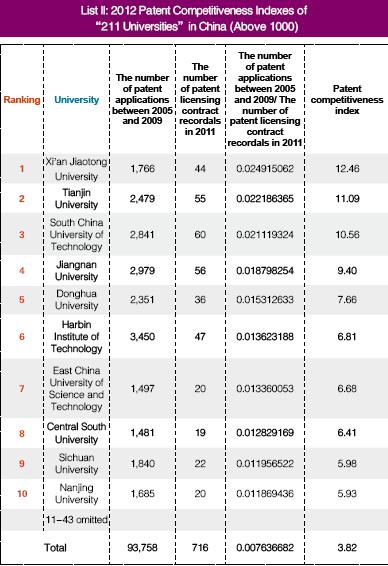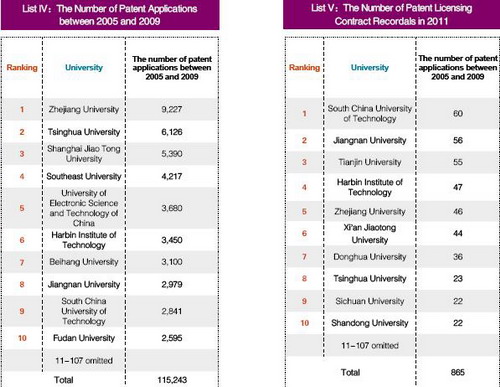I. Statistic resource and acquisition explication
In this report, all statistics and information about patent come from the website of the State Intellectual Property Office of the People’s Republic of China (SIPO), and are divided into two parts:

The first part is the patent licensing status of Chinese universities in 2011. SIPO publishes data of the records of patent licensing contracts annually. Analyzing the statistics in the database, the number of patent licensing contract recordals of each university could be ascertained. The authors believe that the number of patent licensing contract recordals should be substantially equal to the actual number of patent licensing contracts of each university, because under Rule 14.2 of the Implementing Regulations of the Patent Law of the People’s Republic of China “[a]ny license concluded by the patentee with an entity or individual for exploitation of a patent shall, within 3 months from the date of entry into effect of the license, be submitted to the Patent Administration Department under the State Council for recordal.” As recordation is mandatory, a licensor or licensee failing to record the licensing contract within the prescribed time-limit will face unfavorable legal consequences. As national institutions, universities in China normally record their contracts and occasions of not recording should be very rare. Therefore, records of patent licensing contracts at SIPO should reflect the actual patent licensing status of universities.

The second part concerns with the patent application status of Chinese universities between 2005 and 2009. The statistics applied in this report come from the Patent Search Database of SIPO. The reason why comparing the amount of patent applications of universities between 2005 and 2009 is used to compare with the patent licensing amount in 2011 is mainly because that according to analyses on the patent licensing status of universities in 2011, 86% of all recorded licensed patents are applied between 2005 and 2009. With year 2007 and 2008 as a peak, the volume of application could basically form a normal distribution. Therefore, the patent licensing status could be objectively determined by comparing the volume of patent application between 2005 and 2009 with the number of the patent licensing contract recordals in 2011.

The universities involved in this report are universities of Project 211. The name of the project comes from an abbreviation of the 21st century and 100 universities (an approximate number). It is a major project in China which aims to emphasize the construction of approximately 100 national key universities and colleges for the 21st century initiated by the Ministry of Education of the People’s Republic of China (MOE). As a cross-century strategic project under the strategy of rejuvenating the country through science and education, Project 211 aims to raise the overall standard of China’s higher education, cultivate highlevel talents, accelerate national economic construction, promote China’s scientific and cultural development and enhance the comprehensive national strength as well as the country’s international competitiveness. Thus, universities which are included in the project are all strong in educating and researching. Meanwhile, comparing with other universities, the “211 universities” have also received more supports and investments from the central and local governments. Therefore, using “211 universities” as samples in this research adds objectivity and representativeness to the analysis of the overall patent competitiveness of Chinese universities. To date, the MOE has listed 116 universities under the project, including the Peking University and the Tsinghua University.

However, non-211 universities which of course receive less government financing and support are not necessarily inferior to those “211 universities” on patent competitiveness. The patent competitiveness index of Anhui University of Science & Technology, Fujian Normal University, Southwest Petroleum University, Changzhou University, Nanjing Agricultural University, Wuhan Institute of Technology, Jiangsu University and Nanjing University of Technology, etc. are much higher than the average of the “211 universities.”




